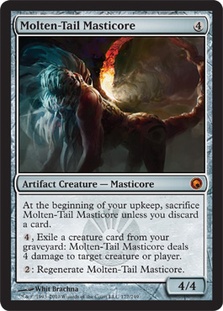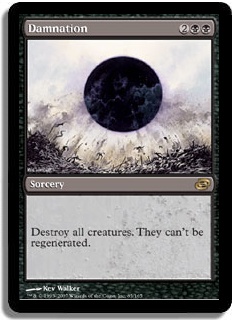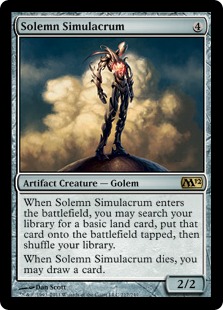In Magic’s recent history, the game has been pushing the power of its two-mana spells and creatures, with recent examples like Stoneforge Mystic, Bitterblossom, Tarmogoyf, and Snapcaster Mage defining many formats (and being amazing in Cube), while cards like Jace, the Mind Sculptor, Elspeth, Knight-Errant and Thrun, the Last Troll have shown the power of four-drops in recent Magic.
When doing some analysis of my cube, I realized that the competition for white four-mana spells is really tight, with white’s four-drops having cards like Elspeth, Knight-Errant, Ajani Goldmane, both Wraths (Wrath of God and Day of Judgment), both “geddons” (Armageddon and Ravages of War), Moat, and Hero of Bladehold, among others.
After looking at all of the other colors in my cube, I realized that all of the colors had extremely competitive four-mana sections (although none of them, aside from arguably blue, are as competitive as white at four mana), with cards like Skinrender, Jace, the Mind Sculptor, Avalanche Riders, and Vengevine in the non-white colors. Clearly, the caliber of powerful creatures and spells at four mana wasn’t just a thing for white decks; it applied to my entire cube: each color, artifact, and multicolor.
In this article, I’ll be discussing the role of four-mana cards in cube: how they work in aggressive, midrange, and control decks, how to draft them in those decks, and how design your cube with this important mana cost in mind.
I’ve seen people define cube aggro decks as decks which have multiple five-, six-, seven-, and eight-drops in their decks, but I’d like to clear up that those aren’t aggressive decks; they’re midrange ones. And using creatures like Savannah Lions and Sundering Titan in the same deck is a recipe for disaster, or at least wastes cards at one end of the converted mana cost spectrum.
Having multiple cards at those high mana costs is too much for truly aggressive decks, as aggro decks will want to top out with only a few four-mana effects, since that’s the point where the aggro deck’s game plan is to win soon after, before cube midrange and control decks can stabilize. Many of the best four-drops for aggressive decks seek to either push the pressure that’s being exerted or to put the “nail in the coffin” though disruptive cards like the classic Armageddon/Ravages of War, Nether Void, Smokestack, and Avalanche Riders or other effects that provide an immediate effect like Skinrender or Vengevine.
Aggressive decks don’t typically mind using other four-drops that don’t provide an immediate effect like Blastoderm/Calciderm as well or Moltensteel Dragon (which is mostly a four-mana creature), but they generally make up for the non-immediacy by providing a lot of bang for their buck. This can be seen in colors like red, whose role is mainly for aggressive decks and whose four-mana spells include Koth of the Hammer, Chandra, the Firebrand, Moltensteel Dragon, and several creatures that trigger when they enter the battlefield like Avalanche Riders, Flametongue Kavu, and Keldon Champion—where the only card that doesn’t have an immediate effect is Moltensteel Dragon (which has the potential to kill someone if unopposed). Other colors like white, with cards like Hero of Bladehold, or green, with Wickerbough Elder or Chameleon Colossus, don’t have the same immediate effect, but provide a useful enough effect so that the effects being non-immediate is offset by the power of the abilities. (Sure, you can Path to Exile my Chameleon Colossus EOT, but can you deal with the rest of my team? Can you afford to let me untap with my Wickerbough Elder so that I can shatter your Ring of Gix?)
When drafting aggressive decks, I’ll windmill slam cards like Armageddon/Ravages of War all day long since they’re absolutely stellar in aggressive decks, and I don’t mind splashing for them even if white dries up, but I generally don’t take four-mana effects that highly in aggressive decks. I’ll only have a handful of four-mana effects in my aggressive decks, so I’m not really in a rush to take one quickly in the draft unless it’s of the Armageddon type. After all, as good as a Blastoderm or a Bonehoard is, I have the rest of the draft to pick up a different four-drop that may fit my aggressive deck better, like an Armageddon or a Nether Void, which is especially important if my aggro deck ends up only having room for a couple of four-mana spells.
On the other hand, in cube midrange and control decks, four mana generally represents the point where those decks want to start taking control of the game by helping them stabilize with cards that destroy multiple creatures/permanents and other types of cards that help to attain card advantage, like card draw spells that draw multiple spells or creatures with enter the battlefield triggers.
In my article on signets and bouncelands in cube, I discussed how signets were deemed to be “too good” for cube, with part of the perceived problem being that signets help midrange and control decks get to the important four-mana mark a turn earlier and that while green could also do that, it didn’t offer anything unique to that color, as the one- and two-mana green accelerants don’t get players to four mana any quicker than signets. While I don’t necessarily agree with the concept of signets being too good for cube and diminishing the importance of green, the concept does at least address how signets aid control to the point where people worry about them being too good—signets and other accelerants help control decks get to four mana, skipping the third turn. However, four-mana effects aren’t vital enough to the point where getting to them a turn earlier via signets makes a cube lopsided towards control and hostile towards aggro and green decks.
Due to the relative importance of four-mana effects for midrange and control decks and the fact that control and midrange decks don’t have the same aversion for using a lot of four-mana effects that aggro decks have, I take four-mana effects relatively highly in those decks, but that’s mainly because four-mana effects tend to be really good in those decks; it’s the converted mana cost of Jace, the Mind Sculptor, Moat, Nevinyrral’s Disk, and Solemn Simulacrum, after all! Obviously there are limits to this rule, as I wouldn’t want a severe glut of cards at four mana even in my most controlling decks, but I don’t tend to fret over the four-mana effects as much as I do in aggressive decks, since I’m able to use a lot more of them in my control decks than aggressive decks.
What does this mean for cube design?
The role of four-mana spells in cube is very important since they’re useful for all three avenues of cube decks: aggro, control, and midrange. Effects like ones at six-mana are almost ignored by aggro decks aside from cards used as solitary curve toppers like Inferno Titan and Sorin Markov, and while ones at one-mana like Swords to Plowshares and Vampiric Tutor are useful for all avenues, aggressively centered ones—particularly one-mana creatures—are much more important to aggro decks and thus end up being the lion’s share of one-mana effects in a cube. Despite aggressive decks not using as many four-mana effects in their decks as midrange and control decks, all three avenues still view the four-mana slot as an important part in their curve, and thus keeping that cost in mind is important, as many of them are universally playable in all three archetypes. I’d be happy to play Flametongue Kavu, Elspeth, Knight-Errant, Masticore, Faith’s Fetters, and Wickerbough Elder in aggressive, midrange, and control decks. However, tempting as it may be due to the importance of four-mana spells for midrange and control decks, you also don’t want your cube to be overly represented by four-mana effects either.
I’ve found that using a converted mana cost average is a good way to make sure that your cube isn’t overburdened by costly spells and effects, using a minimum converted mana cost of 3.00 at least for powered cubes (my cube’s is about 2.83); having a lot of four-mana spells in your cube can be a hindrance to reaching this goal. Having a high converted-mana-cost average can be a measurable sign of aggressive decks having less support, since as was discussed earlier, aggro decks aren’t going to use a lot of four+ mana effects in their decks, giving midrange and control decks a lot more tools than is necessary.
Granted, this measure isn’t perfect, as some cards that are not very good in aggressive decks like Condemn and Enclave Cryptologist are cheap in mana, and there are a lot of spells that are universally playable four-mana effects—like Flametongue Kavu, Murderous Redcap and Elspeth, Knight-Errant—which are useful in both aggressive and control strategies, but the measure works overall. If anything, it’s a good measure of how fast a cube is.
You may have noticed that I don’t tend to give hard numbers on how many cards of a certain type you should use, and that’s for several reasons—one being that a four-drop may help to address the needs of a cube. If a cube was in dire need of artifact/enchantment destruction in white and isn’t using Kor Sanctifiers, that is definitely an option, and using a hard “You should only use nine four-mana effects in white!” stance shuts off that option.
Another is newly printed cards. I was dead-set against using another six-mana creature than Yosei, but the printing of Sun Titan made me change my mind on the rigidity of that mana cost. Granted, you’ll need to be aware of competition at that cost; I’ve had to exclude many four-drops in white which had some potential like Ranger of Eos, Emeria Angel, and Parallax Wave simply because the competition at four mana was insane (as those three cards weren’t better than what I already had). Of course, if there’s something insane that gets printed soon at four mana in white, I may end up having another four-mana white spell or creature in my cube, but today’s not that day.
I hope that this article has given you some important insight into how four-mana spells play an important role in your cube. The concept of examining certain mana costs is one that hasn’t been addressed very much for cube (aside from some whining that green needs more good 6+ mana creatures for cube in my Innistrad review), and being aware of how the different mana costs play out in your cube can be an important tool for not only designing a cube, but drafting one.
May all of your opening packs contain Sol Rings!
@UsmanTheRad on Twitter
My blog, I’d Rather Be Cubing, featuring my powered & pauper cube lists: http://idratherbecubing.wordpress.com
Cube podcast that Anthony Avitollo and I co-host: The Third Power
P.S. – If you haven’t seen the Dark Ascension previewed card “Faithless Looting” from the third MTG Comic, check it out. After doing some testing with the card, it looks like it’ll be a stellar card for aggressive red decks to jettison blank cards in the middle to late game and a decent reanimation enabler in R/B midrange, not to mention shenanigans with Bloodghast, Squee, etc., as sometimes, all you need is some extra value through an ability like kicker or flashback to turn a not-so-great card, Careful Study, into something cubeworthy.
P.P.S. – If you’re going to the SCG Open this weekend in St. Louis and you’re coming in from out of town, you should definitely check out the City Museum in downtown. The best description that I’ve heard is that it’s like walking into an Escher painting, and that’s a pretty spot-on description. It’s definitely the best tourist attraction in town; better than the Arch and open later too, if you end up dropping from the event late.




